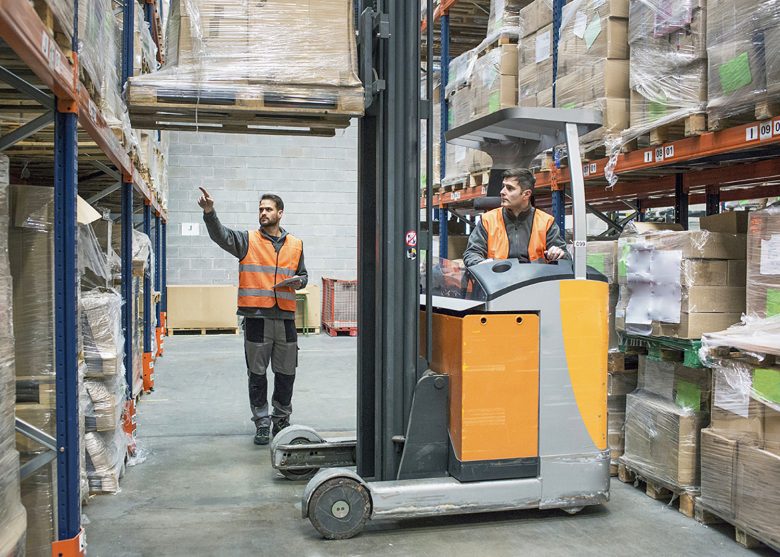When operating specialized equipment in the workplace, employers must work with their staff to help them secure the correct permits, certifications and training. However, preventing forklift incidents in the workplace doesn’t end with filing an application or handing an employee their permit—they can occur at any point in a worker’s career.
Incidents when operating powered industrial trucks (PITs) include overturns, collisions, workers getting struck or crushed, and drivers falling from the forklift. Many, if not all, of these situations are caused by human error, lackluster safety culture, inadequate safety training, faulty equipment and housekeeping issues.
Here’s a closer look at these issues.
1. Lack of primary or ongoing safety training
When it comes to forklift safety, training an employee before they get in the driver’s seat is mandatory but not enough for long-term safety. As time goes by, regulations change, equipment ages or gets replaced, and employees become complacent. All of these factors make refresher training a key component of forklift safety.
Some of the most serious and most common safety problems for PITs include inadequate training, unsafe driving, and unstable loads. Proper refresher training should address all of these issues. Workers need to know exactly what to avoid when driving (including speeding, inattention, choosing not to wear seat belts), how to ensure safe and stable loads and their safe transportation. Without this knowledge and a safety culture to back up safe actions, the likelihood of a serious incident involving a forklift is much higher.
It’s also worth noting that it’s easy to provide the exact same forklift refresher training every year. But doing so would likely lead to workers not paying full attention to the training, leading to low knowledge retention. Strive to keep the forklift training fresh by changing the format and style of training, or adding at least one new element every year.
2. Faulty trucks
A routine and preventative maintenance schedule is crucial in identifying mechanical issues that could be hazardous, ensuring every truck’s continued safe operations, and keeping the financial investments in PITs low. Maintenance should include a visual and operational pre-start check before every shift, and any forklift requiring maintenance should be immediately removed from service.
All repair work performed on vehicles must be compliant with PIT regulations and workers should not perform any repairs on the trucks unless they’re trained to do so. Additionally, no modifications should be made to a forklift if they’re not approved by the manufacturer. Ask the service provider to provide a written list of the maintenance being performed for your records.
3. Housekeeping issues
When workplace housekeeping is a mess it can lead to an unsafe working environment for forklift drivers. For example, a lack of clear driving avenues can easily lead to serious incidents. Untidy floors, objects left in the way of the forklift and obstructions overhead also need to be addressed and prevented.
Creating forklifts-only aisles or putting up barriers can go a long way towards a safer work environment. It’s also a good practice to ensure the floors are clear of obstacles and nothing is going to obstruct the driver’s way from above or below.
4. Employee state of mind
When employees are rushing, frustrated, fatigued or working without awareness, their chances of making a hazardous mistake increase. It’s important for workers to recognize when their thoughts and emotions are getting in the way of their safety. It’s also important for supervisors and safety professionals to know when to intervene or remind the worker to consider their state of mind.
Furthermore, when an employee has been operating a piece of machinery for a significant amount of time, their perception of risk tends to decrease. Though they have become more proficient at their job, the dangers associated with it remain the same. If forklift training doesn’t directly deal with employees’ states of mind then strongly consider introducing human factors training into your safety training program.
5. Lackluster safety culture
When workplace driving safety is neglected by staff or supervisors, it can be challenging to get workers to make safety a priority. Because ignoring a significant safety issue often creates an atmosphere of distrust and can be perceived as the company being uncommitted to the health and well-being of its employees.
There are also workplaces where safety is only addressed after an incident occurs. Even worse is when every incident leads to punitive actions against the “guilty” party. This creates a toxic and harmful working environment where employees stop reporting near misses or even serious incidents to avoid getting in trouble. Such stunted communication not only doesn’t help the overall safety, but it actively disrupts it.
If the safety culture in your workplace is negatively affecting forklift safety, start by observing where it is you need to improve. Begin by bringing unsafe habits to the attention of your staff and implement reporting policies focused on analyzing incidents and underlying problems instead of prosecuting the workers involved. It’s also important for employees to feel empowered enough to put their safety first, so allowing them to take their time to perform a task safely should always be more important than ignoring safety for speed.
It’s worth noting that all five issues mentioned in this article are intertwined. Employees state of mind and culture will influence housekeeping and inspections. Lack of training could influence worker’s ability to manage their state of mind. To properly address one of these issues, you need to take a hard look at all five of them.
When workers are operating equipment that carries with it a high level of risk and requires a license, it’s important that they, as well as those who are overseeing the work, are mindful of the possible injuries and incidents that can occur. Regardless of how experienced an employee is, or how routine the job may feel, the risk of injury is always the same. Addressing the issues noted above can prevent forklift incidents and improve the driving safety in the workplace.

